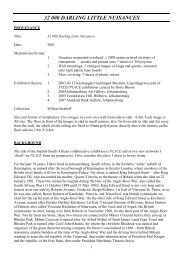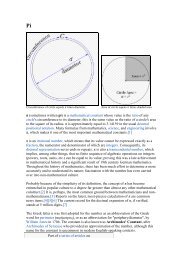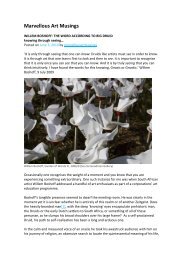Words as things Susanna Laaksonen - Willem Boshoff
Words as things Susanna Laaksonen - Willem Boshoff
Words as things Susanna Laaksonen - Willem Boshoff
Create successful ePaper yourself
Turn your PDF publications into a flip-book with our unique Google optimized e-Paper software.
shapes of <strong>things</strong><br />
A blog about <strong>things</strong>.<br />
15 JANUARY 2007<br />
<strong>Words</strong> <strong>as</strong> <strong>things</strong><br />
Full article: http://shapes-of-<strong>things</strong>.blogspot.com/<br />
Things matter to me -<br />
quiet, humble <strong>things</strong>,<br />
routinely first-rate:<br />
a sharply-honed chisel,<br />
a faithful old kitchen table,<br />
a pale pl<strong>as</strong>ter carving on the windowsill.<br />
Things I look long at,<br />
trying to fix their image in my mind,<br />
<strong>things</strong> I live with this ordinary morning.<br />
In their company I've been at home in my life,<br />
and I still am.<br />
Every morning there they are, waiting,<br />
receiving me <strong>as</strong> an equal.<br />
Quite something, that, isn't it<br />
-Viljo Kajava<br />
About me: My name is <strong>Susanna</strong> <strong>Laaksonen</strong>. I am a Finnish writer with credits in film, TV, theatre, video<br />
art, and other media. You can read more about my work on my website.<br />
Approximately 400 000 pages of different kinds of literature are printed in<br />
the world every minute. I heard this on NPR but have forgotten who said it.<br />
<strong>Words</strong> are like organisms, they are born, they give birth to new words, they<br />
merge, blend, evolve, die. They fill the earth, in myriad languages, dialects,<br />
pidgins and slangs. They are printed on paper, they fill the air, spoken, sung,<br />
bl<strong>as</strong>ted through loudspeakers. They make forays into the deep sea and into<br />
space. Perhaps the language crawling out of me, out of my brain, onto these<br />
electronic pages, and onwards into your brain <strong>as</strong> you read, is a par<strong>as</strong>itical<br />
life form, for the time being using us to be born and to live, all the while<br />
fooling us into thinking we are its m<strong>as</strong>ters and creators. Or perhaps It is God<br />
itself, taking form in human words <strong>as</strong> well <strong>as</strong> insects, rocks and wind. In the<br />
beginning w<strong>as</strong> The Word. Perhaps everything else is shadow.<br />
Concrete poetry is a term coined in the fifties and sixties, when people<br />
started using typography <strong>as</strong> a form of expression. Or perhaps when<br />
language the organism, language the monster, language the Great<br />
Consciousness incarnate, found a clever way to play a little, to express its<br />
independence of us and its ability to reshape our concept of "meaning".<br />
Ubuweb h<strong>as</strong> a great collection of conceptual writing, which takes a further<br />
leap into language-for-itself, away from expressive writing altogether,<br />
revealing language <strong>as</strong> a narcissist, gazing lovingly at itself in the mirror of<br />
the page.<br />
The South African artist <strong>Willem</strong> <strong>Boshoff</strong> h<strong>as</strong> a gorgeous body of work which
often takes concrete poetry <strong>as</strong> its starting point. Through <strong>Boshoff</strong>, language<br />
steps into the concrete world <strong>as</strong> shapes, objects, codes and secrets.<br />
Language is an animal of prey, stalking us in what we thought w<strong>as</strong> our safely<br />
structured and manicured garden of meaning. In the late nineties <strong>Boshoff</strong><br />
created a trilogy of works called Tree of Knowledge. One part in the series,<br />
Letters to God, celebrates the tree in its sacrificial form - the book. The work<br />
studies the fibrous nature and structure of wood, recreating a model of<br />
paper under the microscope. The deconstructed wood pieces conceal letters<br />
of the Greek alphabet, the forbidden fruits of the tree of knowlegde. The<br />
other parts of Tree of Knowledge are Druid's Keyboard and Broken Garden.<br />
In all of these works, language lurks dangerously, <strong>as</strong> a threat to trees and to<br />
us.<br />
In Abamfusa Lawula - the purple shall govern, <strong>Boshoff</strong> gave a concrete form<br />
to slogans and chants shouted in African languages in anti-apartheid rallies.<br />
Here he celebrates spoken language, its power to transform and question. In<br />
Kykafrikaans, he uses a typewriter <strong>as</strong> a writing instrument, "a crochet needle"<br />
and a paintbrush, creating visually ravishing concrete poems. Some of them<br />
act <strong>as</strong> maps that the viewer can only get lost in, glimpsing the occ<strong>as</strong>ional<br />
sliver of meaning. Accompanying the works, created in the seventies, w<strong>as</strong><br />
originally a recital of words in a church. A startled audience w<strong>as</strong> <strong>as</strong>ked to<br />
repeat loudly words such <strong>as</strong> "church" or "sand" or to <strong>as</strong>sert "peel" <strong>as</strong> a<br />
swearword. Did God hear the question behind what w<strong>as</strong> spoken W<strong>as</strong> "peel"<br />
"peel" to God, or w<strong>as</strong> the intention of the speaker what w<strong>as</strong> being said If I<br />
<strong>as</strong>k you to say "peel" <strong>as</strong> a swearword, and you do, are you swearing or am I<br />
Is the church a church because of its name, or because of the intentions of<br />
its builders Can the real intentions be known Is God brought into the<br />
church with the words that are spoken in it<br />
In the eighties, <strong>Boshoff</strong> worked for 370 consecutive days, seven hours every<br />
day, carving a wooden calendar detailing his goals and achievements for<br />
each day. The intricate blocks are carved out of different types of wood, and<br />
were exhibited in giant panels, alphabetized according to the type of wood.<br />
After the initial, brief exhibition they were stored in a specially made set of<br />
drawers. Part of the key to the secret symbols on the blocks is in two red<br />
notebooks, buried within all the wood chips from carving the blocks, in the<br />
b<strong>as</strong>e of the storage system.<br />
The 370 Days Project seems to me a gorgeous poem about the universe,<br />
about the secrets at its root, and about what we can know. A language<br />
known only to itself can only reveal itself to us in glimpses, in segments of<br />
code, in shapes which we may or may not misinterpret. Finally uninterested<br />
in stalking us, having discovered enough entertaining ways to manifest itself<br />
through us, language retreats from the garden. We hear only a slight rustle<br />
<strong>as</strong> it, like a jaguar, softly leaps into the great jungle. The story is not<br />
something that we can even begin to know. We are left to prune our bushes,<br />
plant our flowers in rows and harvest our fruit trees, creating order instead
of meaning.<br />
(Information for this post w<strong>as</strong> harvested from <strong>Willem</strong> <strong>Boshoff</strong>'s website, and<br />
the photograph of Letters to God is his copyrighted material.)








